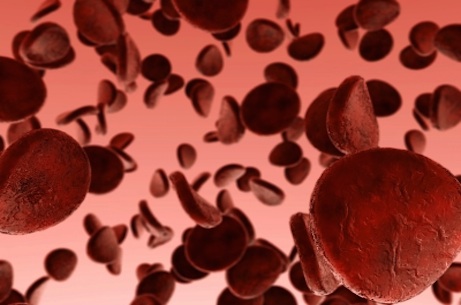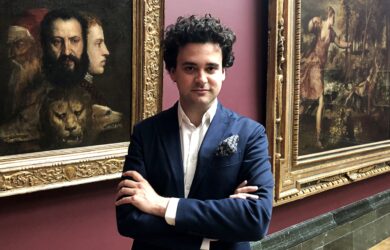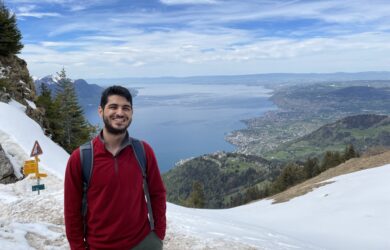
Gates Cambridge Alumnus Edward Chouchani is lead author of a new study on a new drug which could prevent tissue damage following heart attack.
Scientists led by the Medical Research Council (MRC) and University of Cambridge have developed a new drug that could help reduce the tissue damage that occurs following a heart attack, stroke or major surgery.
Tests in mice have shown that the compound, called MitoSNO, protects heart tissue from reperfusion injury, which occurs when blood flow is restored suddenly after a prolonged period without oxygen. The research is published today in the journal Nature Medicine and Gates Cambridge Alumnus Edward Chouchani is lead author.
All of the 100,000 people a year in the UK who suffer a heart attack will experience reperfusion injury. During a heart attack, the major vessels that supply the heart with blood become blocked, preventing oxygen from reaching an area of the heart tissue. When the patient reaches hospital, doctors remove the blockage using medicines or surgery and restore blood flow to the heart.
By this stage, some damage will already have occurred to the oxygen-starved tissue. But most of the damage actually happens when the blood supply is returned suddenly, triggering the production of harmful molecules, called free radicals, in the cell’s powerhouse – the mitochondria.
MitoSNO works by briefly ‘switching off’ the mitochondria in the first few minutes after blood flow is returned to prevent a build-up of free radicals that can kill heart cells. To achieve this, MitoSNO is designed to accumulate inside heart mitochondria rapidly after its injection into the blood.
Dr Mike Murphy from the MRC Mitochondrial Biology Unit, who led the study, said: “When cells are starved of oxygen for any length of time, they begin to shut down. When blood rushes back the mitochondria go into over-drive, churning out free radicals that cause the cells to die. MitoSNO effectively flicks a switch in the mitochondria, slowing down reactivation during those critical first minutes when blood flow returns and protecting the heart tissue from further damage.
“We think a similar process happens in other situations where tissue is starved of oxygen for a prolonged period, for example after a stroke or during surgery where major arteries are clamped to prevent blood loss. We are hopeful that if human trials of MitoSNO are successful it could eventually be used in many other areas of medicine.”
MitoSNO was developed at the MRC Mitochondrial Biology Unit by Dr Murphy’s team in collaboration with Professor Rob Smith of the University of Otago, New Zealand. Together they specialise in creating new molecules that can enter cells and act specifically on mitochondria. The authors say the fact that MitoSNO works when given as blood is restored to the oxygen-deprived heart is a unique strength, because it could be given to heart attack patients when they get to hospital while blood flow to the heart is restored by reopening the blocked artery with a catheter. At the moment there are no established treatments that can be given at this crucial time.
In the study, the researchers tested MitoSNO in a mouse model of heart attack. MitoSNO was given to the mice by injection just before blood flow to the heart was restored. The area of damaged heart tissue was significantly reduced in the mice that had received MitoSNO compared with the control animals, showing that MitoSNO prevents cell death during reperfusion.
Dr Thomas Krieg from the University of Cambridge, a co-author of the study, said: “There have been some important advances in cardiac medicine in recent years and as a result more people now survive a heart attack than ever before. However, we still have no effective treatments to protect against reperfusion injury. By preserving more of the healthy heart tissue, we hope that we can give people who survive a heart attack an improved quality of life. The fact that there were marked reductions in the total area of damaged heart tissue in our study is also significant because, in humans, this has been linked to survival rates.”
Edward Chouchani [2008], who has just completed his PhD in Biological Science, said: “This exciting work helps us understand a key process that causes heart tissue to die during a heart attack, a mechanism by which this damage can be prevented, and a targeted drug strategy with efficacy at a pre-clinical stage. It has been fascinating to conduct this research to better understand the molecular underpinnings of a major cause of death, and hopefully this work will lead to therapeutic strategies that can save lives.”
The researchers now hope to secure funding to test their new compound in early human studies.
Professor Stephen Hill, Chair of the MRC’s Molecular and Cellular Medicine Board, which funded the research, said: “We’ve known for a long time that the mitochondria are central to the damage caused by reperfusion injury, but the mechanics of this process at a molecular level have been unclear. These important findings demonstrate the importance of investing in basic laboratory research, which underpins our understanding of human health and disease. In addition, this work indicates that a new class of drug developed by MRC scientists may be worth extending to human trials.”
The research was carried out in collaboration with the University of Rochester, UCL and University of Glasgow and was funded by organisations including the MRC, the Biotechnology and Biological Sciences Research Council and the British Heart Foundation. The technology has been patented by MRC Technology on behalf of the MRC and is available for available for collaborative development and/or licensing.
To read the article, click here.
Picture credit: Ideas Go and www.freedigitalphotos.net












